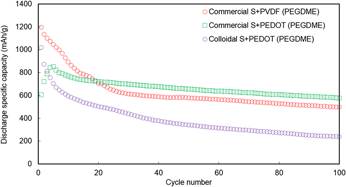Crossref Citations
This article has been cited by the following publications. This list is generated based on data provided by
Crossref.
Xu, Guiyin
Ding, Bing
Pan, Jin
Nie, Ping
Shen, Laifa
and
Zhang, Xiaogang
2014.
High performance lithium–sulfur batteries: advances and challenges.
J. Mater. Chem. A,
Vol. 2,
Issue. 32,
p.
12662.
Wu, Feng
Zhu, Qizhen
Chen, Renjie
Chen, Nan
Chen, Yan
and
Li, Li
2015.
A Safe Electrolyte with Counterbalance between the Ionic Liquid and Tris(ethylene glycol)dimethyl ether for High Performance Lithium-Sulfur Batteries.
Electrochimica Acta,
Vol. 184,
Issue. ,
p.
356.
Lin, Zhan
and
Liang, Chengdu
2015.
Lithium–sulfur batteries: from liquid to solid cells.
Journal of Materials Chemistry A,
Vol. 3,
Issue. 3,
p.
936.
Ai, Guo
Dai, Yiling
Ye, Yifan
Mao, Wenfeng
Wang, Zhihui
Zhao, Hui
Chen, Yulin
Zhu, Junfa
Fu, Yanbao
Battaglia, Vincent
Guo, Jinghua
Srinivasan, Venkat
and
Liu, Gao
2015.
Investigation of surface effects through the application of the functional binders in lithium sulfur batteries.
Nano Energy,
Vol. 16,
Issue. ,
p.
28.
Pan, Jin
Xu, Guiyin
Ding, Bing
Chang, Zhi
Wang, Aixiu
Dou, Hui
and
Zhang, Xiaogang
2016.
PAA/PEDOT:PSS as a multifunctional, water-soluble binder to improve the capacity and stability of lithium–sulfur batteries.
RSC Advances,
Vol. 6,
Issue. 47,
p.
40650.
Ai, Guo
Wang, Zhihui
Dai, Yiling
Mao, Wenfeng
Zhao, Hui
Fu, Yanbao
En, Yunfei
Battaglia, Vincent
and
Liu, Gao
2016.
Improving the over-all performance of Li-S batteries via electrolyte optimization with consideration of loading condition.
Electrochimica Acta,
Vol. 218,
Issue. ,
p.
1.
Dirlam, Philip T.
Glass, Richard S.
Char, Kookheon
and
Pyun, Jeffrey
2017.
The use of polymers in Li‐S batteries: A review.
Journal of Polymer Science Part A: Polymer Chemistry,
Vol. 55,
Issue. 10,
p.
1635.
Xu, Guiyin
Yan, Qing-bo
Kushima, Akihiro
Zhang, Xiaogang
Pan, Jin
and
Li, Ju
2017.
Conductive graphene oxide-polyacrylic acid (GOPAA) binder for lithium-sulfur battery.
Nano Energy,
Vol. 31,
Issue. ,
p.
568.
Yuan, Hong
Huang, Jia‐Qi
Peng, Hong‐Jie
Titirici, Maria‐Magdalena
Xiang, Rong
Chen, Renjie
Liu, Quanbing
and
Zhang, Qiang
2018.
A Review of Functional Binders in Lithium–Sulfur Batteries.
Advanced Energy Materials,
Vol. 8,
Issue. 31,
Wang, Yazhou
Huang, Xiaoxiao
Zhang, Shanqing
and
Hou, Yanglong
2018.
Sulfur Hosts against the Shuttle Effect.
Small Methods,
Vol. 2,
Issue. 6,
Jeong, Tae-Gyung
Lee, Yoon-Sung
Cho, Byung Won
Kim, Yong-Tae
Jung, Hun-Gi
and
Chung, Kyung Yoon
2018.
Improved performance of dual-conducting polymer-coated sulfur composite with high sulfur utilization for lithium-sulfur batteries.
Journal of Alloys and Compounds,
Vol. 742,
Issue. ,
p.
868.
Yan, Longlong
Gao, Xiguang
Thomas, Joseph Palathinkal
Ngai, Jenner
Altounian, Haig
Leung, Kam Tong
Meng, Yuezhong
and
Li, Yuning
2018.
Ionically cross-linked PEDOT:PSS as a multi-functional conductive binder for high-performance lithium–sulfur batteries.
Sustainable Energy & Fuels,
Vol. 2,
Issue. 7,
p.
1574.
Hencz, Luke
Chen, Hao
Ling, Han Yeu
Wang, Yazhou
Lai, Chao
Zhao, Huijun
and
Zhang, Shanqing
2019.
Housing Sulfur in Polymer Composite Frameworks for Li–S Batteries.
Nano-Micro Letters,
Vol. 11,
Issue. 1,
Huang, Sheng
Guan, Ruiteng
Wang, Shuanjin
Xiao, Min
Han, Dongmei
Sun, Luyi
and
Meng, Yuezhong
2019.
Polymers for high performance Li-S batteries: Material selection and structure design.
Progress in Polymer Science,
Vol. 89,
Issue. ,
p.
19.
Qi, Qi
Lv, Xiaohui
Lv, Wei
and
Yang, Quan-Hong
2019.
Multifunctional binder designs for lithium-sulfur batteries.
Journal of Energy Chemistry,
Vol. 39,
Issue. ,
p.
88.
Fang, Chen
Zhang, Guangzhao
Lau, Jonathan
and
Liu, Gao
2019.
Recent advances in polysulfide mediation of lithium-sulfur batteries via facile cathode and electrolyte modification.
APL Materials,
Vol. 7,
Issue. 8,
Kwok, C. Y.
Pang, Q.
Worku, A.
Liang, X.
Gauthier, M.
and
Nazar, L. F.
2019.
Impact of the Mechanical Properties of a Functionalized Cross-Linked Binder on the Longevity of Li–S Batteries.
ACS Applied Materials & Interfaces,
Vol. 11,
Issue. 25,
p.
22481.
Lopez, Jeffrey
Mackanic, David G.
Cui, Yi
and
Bao, Zhenan
2019.
Designing polymers for advanced battery chemistries.
Nature Reviews Materials,
Vol. 4,
Issue. 5,
p.
312.
Hong, Xiaodong
Liu, Yue
Li, Yang
Wang, Xu
Fu, Jiawei
and
Wang, Xuelei
2020.
Application Progress of Polyaniline, Polypyrrole and Polythiophene in Lithium-Sulfur Batteries.
Polymers,
Vol. 12,
Issue. 2,
p.
331.
Weret, Misganaw Adigo
Jeffrey Kuo, Chung-Feng
Zeleke, Tamene Simachew
Beyene, Tamene Tadesse
Tsai, Meng-Che
Huang, Chen-Jui
Berhe, Gebregziabher Brhane
Su, Wei-Nien
and
Hwang, Bing-Joe
2020.
Mechanistic understanding of the Sulfurized-Poly(acrylonitrile) cathode for lithium-sulfur batteries.
Energy Storage Materials,
Vol. 26,
Issue. ,
p.
483.



